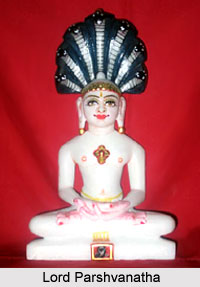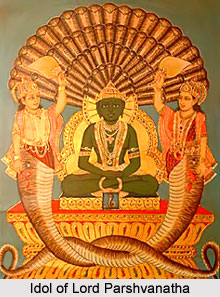 Lord Parshvanatha was the twenty-third Jain Tirthankara. He was born in Varanasi as the son of King Asvasena and Queen Varna in the Iksvaku Dynasty. He was known as purisadaniya that means beloved of men.
Lord Parshvanatha was the twenty-third Jain Tirthankara. He was born in Varanasi as the son of King Asvasena and Queen Varna in the Iksvaku Dynasty. He was known as purisadaniya that means beloved of men.
Early Life of Lord Parshvanatha
After a carefree youth spent in the royal grand palace of his father, he was touched at the age of 30 by the unsteadiness of all that was worldly. Thus, he renounced the world and became an ascetic. He practiced austerities for eighty three days and on the eighty fourth day he obtained omniscience. He obtained the redeeming knowledge in a short time and dedicated himself immediately to the propagation of the truth found by him. When he had attained the age of 100, he climbed the Sameta Sikhara in Bihar (which is now called Parasnath hills after him), where he went into Nirvana after refusing to take any food or water for a month.
Tenets of Lord Parshvanatha
 According to the accounts of Jains, the main tenets of Parshvanatha`s doctrine, were as follows: The whole, uncreated and imperishable universe is filled up in its three sections, the upper world of gods, the middle world of human beings, animals and plants and the nether world of demons and other beings in hell, with an endless number of eternal, indestructible individual souls. These souls i.e. Jiva are purely spiritual. They possess infinite knowledge, unlimited power, external moral perfection and they have the same position. However, most of the souls in the world are subject to the vicissitudes of joys and sorrows, their knowledge, their power and their normal condition is imperfect, and an inescapable destiny elevates them to the heights of life, gives them pleasure, power and wealth or throws them down to the of depths of misery, servitude and poverty. According to Parshvanatha the souls remain infected with material objects till they yield themselves to their desires without any restraint and till they attract and assimilate them again and again by their unbridled action. According to him the doors of the five senses should not be carelessly left open to external influences; thinking should be subjected to stricter norms; the four passions: anger, pride, deceit and greed, are to be suppressed; and the will-to-live proliferating in the heart like a poisonous plant has to be completely uprooted. Observance of the four rules assists one in realizing this goal.
According to the accounts of Jains, the main tenets of Parshvanatha`s doctrine, were as follows: The whole, uncreated and imperishable universe is filled up in its three sections, the upper world of gods, the middle world of human beings, animals and plants and the nether world of demons and other beings in hell, with an endless number of eternal, indestructible individual souls. These souls i.e. Jiva are purely spiritual. They possess infinite knowledge, unlimited power, external moral perfection and they have the same position. However, most of the souls in the world are subject to the vicissitudes of joys and sorrows, their knowledge, their power and their normal condition is imperfect, and an inescapable destiny elevates them to the heights of life, gives them pleasure, power and wealth or throws them down to the of depths of misery, servitude and poverty. According to Parshvanatha the souls remain infected with material objects till they yield themselves to their desires without any restraint and till they attract and assimilate them again and again by their unbridled action. According to him the doors of the five senses should not be carelessly left open to external influences; thinking should be subjected to stricter norms; the four passions: anger, pride, deceit and greed, are to be suppressed; and the will-to-live proliferating in the heart like a poisonous plant has to be completely uprooted. Observance of the four rules assists one in realizing this goal.
Iconography of Lord Parshvanatha
Lord Parshvanath is always symbolized with the hood of a snake shading his head. The Yaksha Dharanendra and the Yakshi Padmavati are often shown adjoining him. There was a popular story representing this. Parshvanatha is symbolized in `Padmasana` (lotus) posture in Jain canonical literature. He is represented in `padmasana` posture with both palms and feet, with auspicious lotus marks on them, placed upward. He is portrayed as having blue-black complexion, which is the colour of the cosmos. The seven-hooded serpent Shesha with an umbrella-like unfurling its hoods over the deity, represented elements of the earth and the ocean and has hence a similar body colour. Parshvanatha is depicted as wearing a gem studded crown and other ornaments. He has a golden throne as a seat and a rich covering above.
According to the Kalpasutra, Parshvanatha had won over thousands for his doctrine. 1,64,000 men and 3,27,000 women joined him as lay disciples by acknowledging that his principles were true, and followed these as far as it was possible for the people leading a mundane life. But 16,000 men and 38,000 women tried to practise his ascetic ethics with all its consequences and formed the monk- and the nun-orders




















